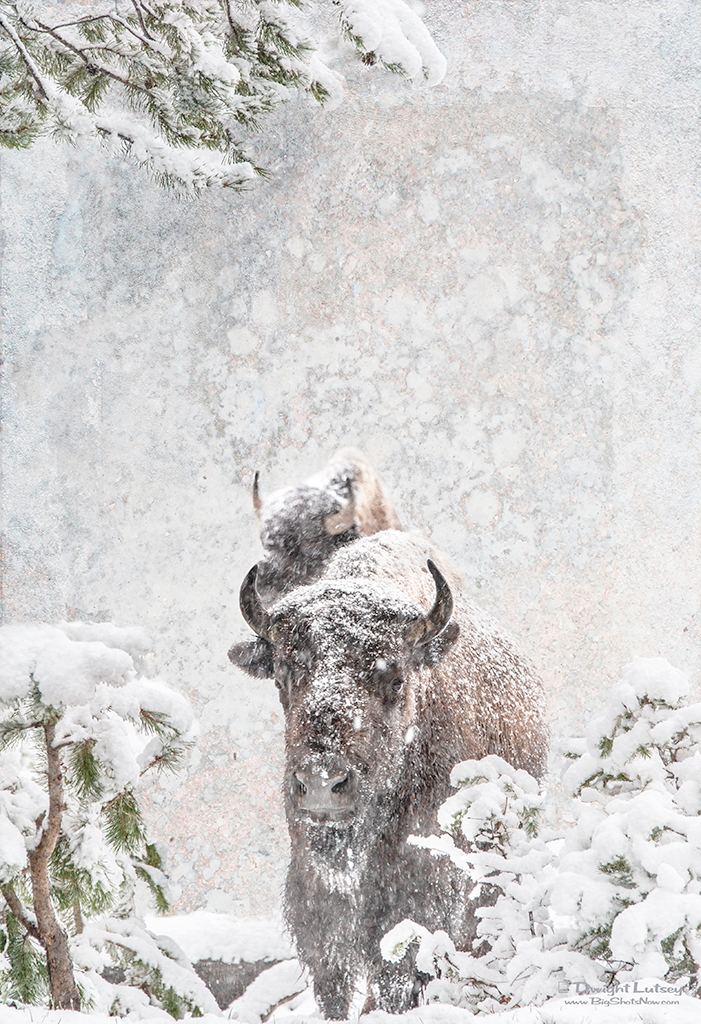
Is this 2021? We have been busting hump to get here. You’re sure it’s 2021 and not last year. We couldn’t take it if this wasn’t 2021. OK then, good.
Now where’s all this extra hay we’re supposed to get?

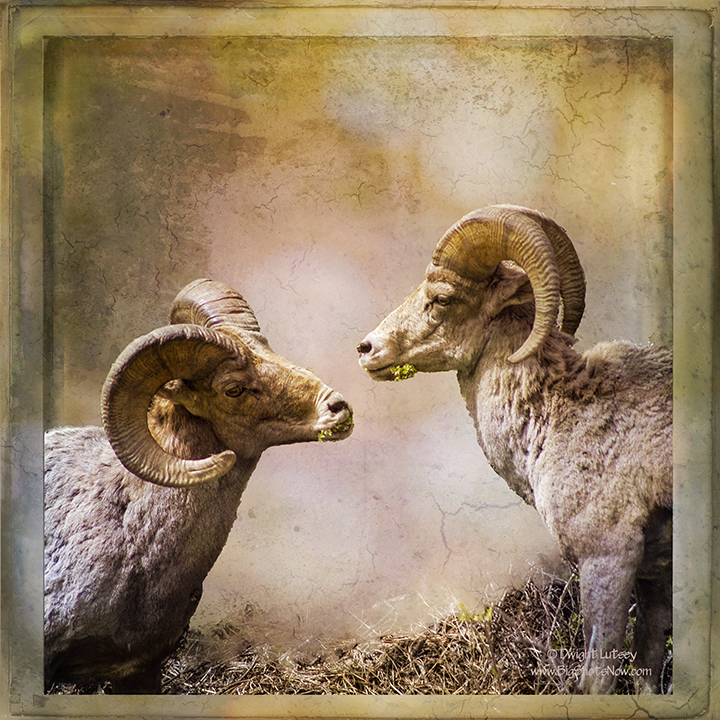
What started out as a quiet leisurely lunch of mountain mahogany leaves soon turned into the beginnings of a serious altercation between the two Bighorn rams. Tyrone and Lambrè usually the best of friends, were standing quietly as they normally did slowly finishing their lunch when Tyrone said “Your horns are looking sort of puny” just low enough that Lambrè wasn’t sure he heard him correctly.
“What did you say ?” Lambrè asked, “I didn’t quite catch that.”
“I said, you’re looking kind of puny, horn-wise. What, are you hard of hearing besides ugly”.
Lambrè gave him a slow sideways glance, considering his answer before replying “What is your problem Tyrone? You been hitting the Gypsum weed again. You know that stuff makes you say stupid stuff.”
In the same quiet voice Tyrone said ” I’m just saying I think you’re looking puny and I don’t believe you got a set of juevos to come up against me in the rut here this fall.”
“Tyrone, what are you getting all chesty for that’s two and a half months or more from now. You mean we gotta do this for another couple of months?”
There it starts, the trash talk that leads up to the full on battle between two Bighorn rams every fall when the rut starts. For those of you unfamiliar with the Rut that’s when the rams begin fighting with each other to determine who gets to mate with the females in the herd. It is a battle unmatched by other species except the Elk and Buffalo who do the same thing, fighting to assume supremacy for mating rights, and it can be deadly, though it usually isn’t, just embarrassing for the loser.
Most people are only aware of the actual battles where the rams stand off facing each other then lunge forward driving their heavy horns into the other rams head, with the idea of stunning their opponents or making them turn tail and run away, and not the verbal sparring that goes on during the last weeks of summer while the rams attempt to psych out their opponents. When this event takes place the actual collision of the two animals meeting sounds like a gunshot and can be heard throughout the countryside. Rarely but not unheard of, sometimes an opponent is pushed over the side of a cliff or down a ravine breaking a leg or a neck and of course losing his mating rights along with his life.
The Rut is the most serious event in a Bighorn rams life and it is why everything is fair game as far as psyching out his opponent. Anything can be said and is, to gain that last little edge of advantage. Which is why we hear Tyrone saying to Lambrè just as quietly as before “Hey Lambrè, Yo Mama….” and we all know where that’s going. You may see a preview of the rut before it even starts.
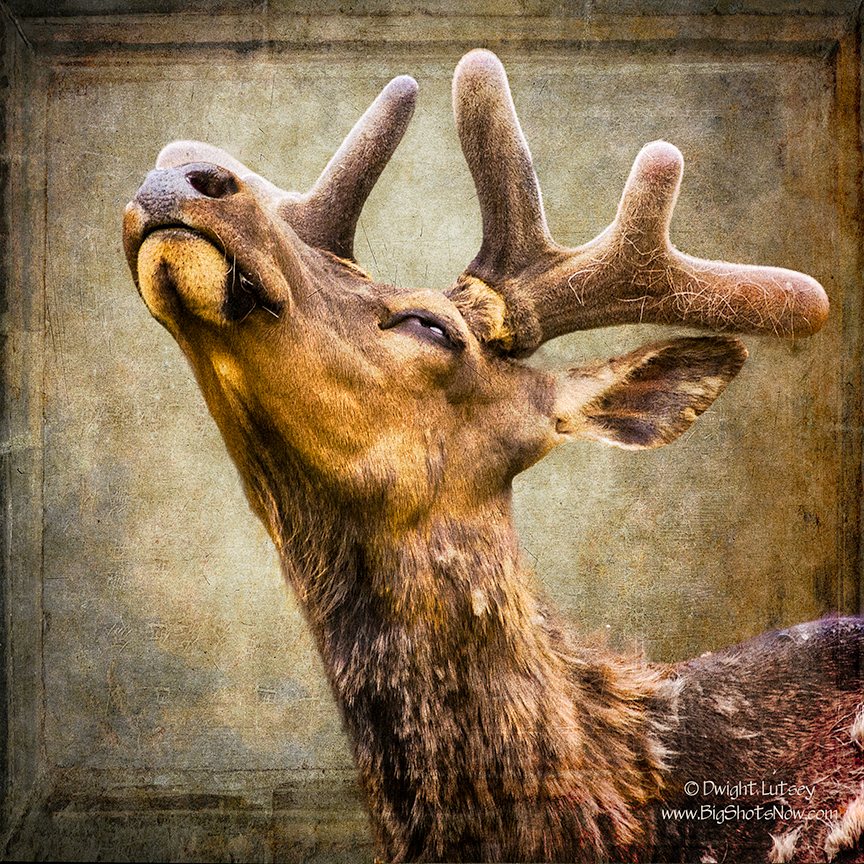
It’s Spring again and everything has been just as crazy up in Yellowstone National Park as it has been down here what with the threat of various virus’s and other problems such as layoff’s, furloughing, high unemployment amongst the animals that are the heart of Yellowstone. It has been a troublesome Spring. Every year when it gets close to the park reopening the National Park Service instructs the Federal Fish and Wildlife department to inventory, catalog, determine specie fitness and check each animal prior to opening the park for this years visitors. The animals need to ready for the long days of being on display and performing whatever their particulars species activities require.
As you might imagine this is a very large undertaking due to the size of the wildlife population that normally resides in the park. Just inventorying the Yellow-rumped warblers takes forever and they’re only one species out of 300 that call the park home. The initial groups brought in for re-indoctrination of park guidelines and requirements are of course, those species that are large enough to be problematic regarding interaction with the tourists, who as you would expect, have paid a large sum of money to view the wildlife and be entertained. They have high expectations due to being cooped up for the last several months with nothing to do but watch Nature programs on TV. Fortunately there are activities that the largest animals can participate in, such as Buffalo Soccer which is perfectly suited to the buffalos mentality and physique, and is a huge favorite of the foreign visitors to the park. You can expect to hear Gooooooal ! all thru the Hayden valley once the games start.
Other large animals that can require management due to their propensity for violence and misbehavior are the hooved ungulates, such as the Rocky Mountain Elk, who have a huge representation in the park. Mostly they are not considered to be a problem early on as they just eat and grow antlers until Fall approaches. Then they shed their antlers and begin to get all chesty as the “Rut” gets nearer. That’s where they get to choose as many cows as they can get their hooves on. Then it’s “Katy Bar the door!” as all hell breaks loose when these big boys battle to decide who the bull duck in the pond is going to be and who gets to keep all those cows they claimed. When this is happening no one can get near them without something terrible happening, as these 1200 lbs. love buckets care for only one thing and that is mating. The last thing on their minds is being sociable with tourists regardless of what those folks saw on TV. These animals are not here to be your new best friends.
To try and keep the damage down to a manageable level the Fish and Game department is trying something new this year. Yoga. One of the senior officials in the department was informed by his wife that Yoga is good for managing stress and anxiety, something these bulls have plenty of as they wait for the velvet to fall off their antlers, so why don’t you try Yoga to see if it doesn’t do the trick for settling these boys down. There have been several articles in Cosmo, Elle and Vogue that stated this was the new best thing to do and since this dialogue took place over a pitcher of Margaritas, there you have it. Yoga in the park and attendance is mandatory. The young fellow above is in his new favorite pose, Upward Facing Bull and as you can see by the sheer bliss settling over his face it appears to be working. Lets’ see how this all holds up in September when the Rut is starting. They may have to give Cosmos a call and get a retraction.
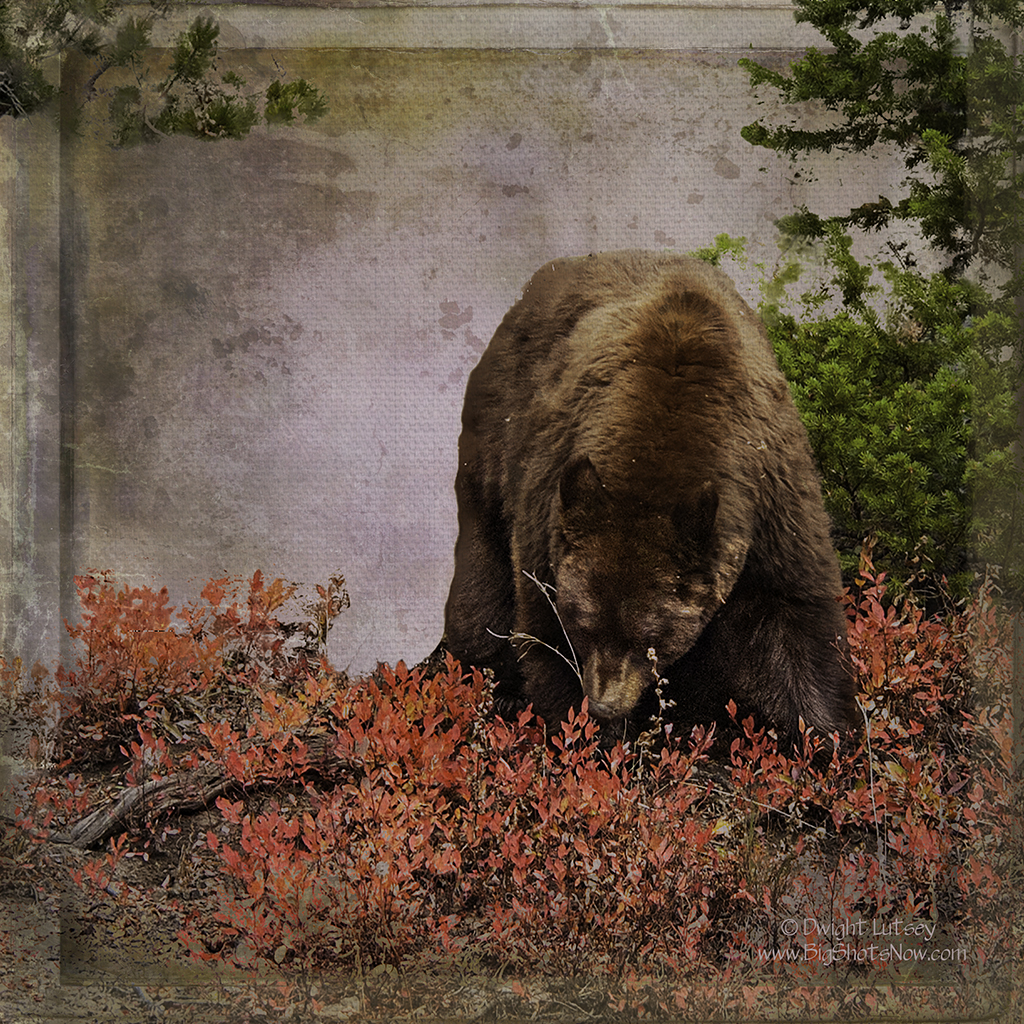
Many times as you stroll amongst bears you will hear them singing or humming various melodies under their breath. This is especially true in Yellowstone National Park, a place where you can interact with bears on many different levels. At first you may not pick up on the fact that they are actually producing musical renditions of current musical selections as they go about their usual bear business, whether that business is eating road kill, or gently plucking flowers out the surrounding shrubbery, or simply rending a newborn elk calf down into its lowest common denominator. They are singing.
As with human people, bears like various types of music. Grizzlies for instance, are most fond of Gregorian chants and when they gather around a freshly killed buffalo you will almost certainly hear certain choral works such as Bach’s ‘Mass in B Minor’ or even Brahms’s ‘A German Requiem’. They can often be identified by the music they choose to sing when you can not see them, like you identify birds by their unique songs. For instance if you should perhaps be hiking near Mt. Mary’s trail and hear the refrains from Beethoven’s ‘Missa Solemnis’ or even Mozart’s ‘Mass in C minor K. 427 “The Great”, coming from somewhere in the nearby bush, stop immediately and ring the bejezus out of your bear deterrent bells very loudly, as loudly as you can, that is a Grizzly. As beautiful as the music is it might be prudent now to turn around and quickly leave the area as this music stirs great passion in these bears and it’s best to not speak to them even if you liked the music.
Then of course, you have the black bears. A bear of many colors ranging from jet black to red, brown, even a golden color, tho that is pretty rare. Black bears have different musical tastes entirely. These bears are fun bears, with a great sense of rhythm and style and a most pleasing tone when they sing. You can actually spend a little time with them as they appreciate an audience and will choose a piece of music that they know the listener will get into. Such as anything by Joe Cocker, Arron Neville or John Prine. Bonnie Raitt and Emmy Lou Harris are favorites for the lady bears. And of course Etta. Just don’t sing along with them. They don’t like that.
There is one truth about black bears and that is as a group down to the last hairy one, they love the Beatles. Perhaps that is too conservative a phrase. They absolutely without a doubt are obsessed with them. So much so that when you see newborn cubs recently out of the den they will be playing and gamboling while singing The Yellow Submarine at the top of their tiny little bear lungs. How is this possible? Genetics, that’s how.
Our friend in the image above just stumbled across some shrubbery that reminded him of one of his favorite songs, Strawberry Fields Forever. Let’s stop and listen for awhile, shall we?
As Fall closes in on us all the animals in the park are preparing for the winter. For some like the Yellow-bellied Marmot this means gathering all the grass that it can stuff in its burrow. If you’re a buffalo not only do you stuff your big fat face with all the grass and foliage that you can, you also grow a thick mat of hair all over your body and especially on your face. This will allow you to push that face into the snow over and over again looking for that old frozen grass and not freeze your nostrils off.
Birds for the most part, being infinitely smarter than other animals just bail as soon they notice the cold and head for places that are warm. Miami, Rio, South Texas. They don’t bother with all that extra feeding. It’s hard to fly if you’re a 15 lb. Bluebird, so they opt for dining lightly on the trip south.We could go on and on about all the idiosyncrasies of the different animals preparing for winter but you all have cable, you watch the Animal Planet so you’re pretty aware of all the preparations they make.
What you may not know however is the huge amount of prep and practice that goes into the bears preparation for wintering over in Yellowstone. Especially grizzlies. Yes, you know about going in the cave, sleeping, then doing that some more until winters over and it’s safe to come out. But what you don’t know is how difficult it is for a naturally active grizzly bear to just go into that cave and go to sleep and stay that way for like six months or more sometimes.
He’s just had a very full summer of dashing around eating Elk calves, tearing the lids off of garbage cans, biting the occasional tourist, fighting with other grizzly bears, thinking bear thoughts, leaving bear tracks along the lake’s edge for tourists to find so they can see how big he is, having to deal with those pesky wolves, getting the occasional ear tag for some infraction or other. It’s a lot of work being a grizzly and along about November or even late October they have to go to bed again. Except they’re really amped. They are pumped up from the busy summer and sleep is the last thing on their minds.
They’re thinking about all the cool stuff they got away with this summer, pulling the door off that camping trailer, hooking up with that hot little female, running off before the rangers could shoot it with those rubber bullets. There’s no way it’s going to sleep.
But sleep it must. They can’t be up and goofing around during the winter, that’s not how this whole bear thing works. It’s designed for the bear to sleep for the winter or else everything just goes all wonky and we can’t have that. After an exhaustive study to see how these grizzly bears handle this problem it was found that they have developed a pretty inventive solution to it. They practice sleeping. That’s it. Just practice. Every chance they get, like after a great big meal of freshly killed buffalo for instance, they just crap out along side the carcass and sleep for as long as they can. That’s what this guy in the picture above is doing. You can’t see the carcass because he’s sprawled on top of it to keep the magpies and ravens from getting it. In a while he’ll wake up and eat some more, then go back to sleep again and will repeat this maneuver until he’s got the ability to got to sleep at the drop of a shinbone. This repetition of eating and sleeping gets his weight up to about eight hundred plus pounds or so, kind of like when we eat that Family size, Papa’s Favorite Pizza from Papa Murphy’s with extra red sauce and cheese at 2:30 in the morning and wake up later unable to fit our shoes on.
This is how they get all the sleep experience they require to stay asleep for months. This is also the time they perfect their dreaming skills. To see what they dream about check out this previous post http://www.bigshotsnow.com/2014/11/09/ and it will tell you all you need to know about Bear dreams. It won’t be long now before all that practice will be put to good use. The leaves will fall, the winds turn cold, and the long trek up the mountain to enter the cave he has used for the last six years will begin. Fortunately the bear has prepared himself well and as soon as he gets settled in and gets all turned around just right with his nose pointed toward the entrance, he will do that thing he does to cause him to fall asleep and that’s it. He’s in for the duration. He’ll sleep until the first trickle of melting snow runs down his back. Then he’ll be up and at it again. Nature has come full circle.
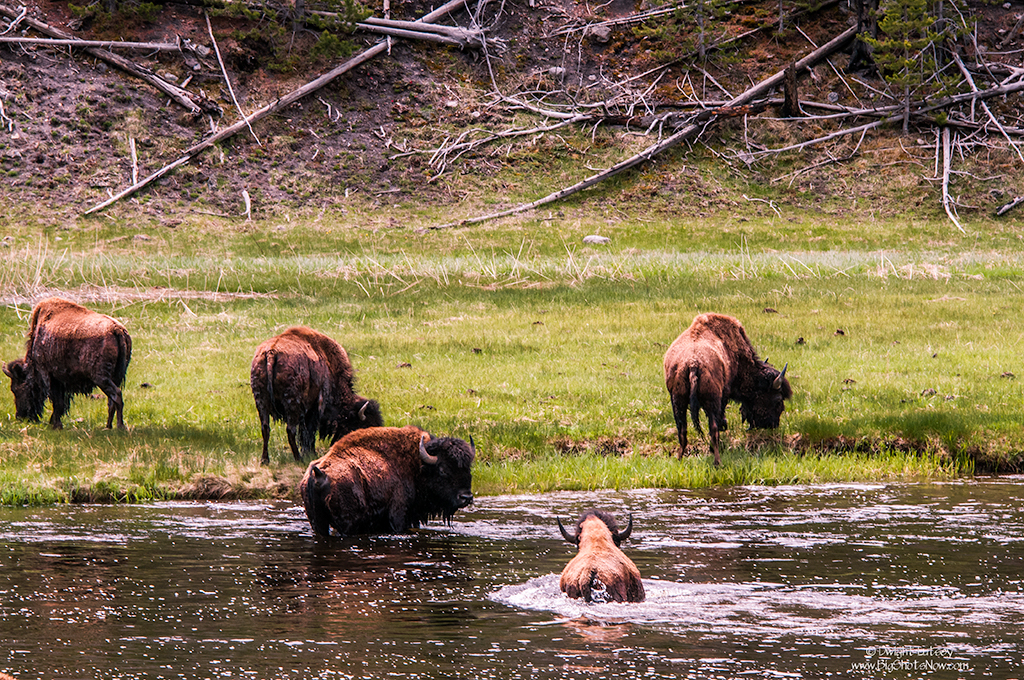
In Yellowstone as well as many other places the old adages are still in use and in the case of the Buffalo, followed religiously as well. If you observe carefully you can often see them being acted out. “The grass is always greener on the other side of the (add your own barrier here)” is the one being followed at the moment.
Perfectly intelligent looking Buffalo will be quietly grazing alongside the Madison when one of them will look across the river and with a bellow race directly into the frigid water to get to the other side where the grass is obviously greener. Soon every member of the herd will be on the other side wondering why their privates are freezing and doesn’t this grass taste exactly like the grass they were just eating a few moments ago.
But an adage is an adage so there must be some purpose in having them. It can’t be just to wash their undercarriage. It must be a case of one of them overhearing it somewhere and not being the mental giants of the ungulate world, decided it must be important or someone smarter than him wouldn’t of said it. Why the rest of the herd follows him is easy to understand. If you were able to look inside that great shaggy head, which is nearly 3′ wide and weighs over 250 lbs. of solid bone except for the small cavity right in the center that the brain resides in, you would see a buffalo command center roughly the size of a very small clock radio. The commands to go left, right, forward but not backward, buffalo do not back up, lie down, get up, fight with whomever is nearest your cows, make small buffalo, gore the occasional tourist and have room for one or two adages, one of which is always “The grass is always greener on the other side of the (add your own barrier here)” The other might be “Stand in the middle of the road until all traffic is backed up at least 17 miles in either direction, then lie down.” That isn’t generally a well-known adage outside the park but it is a big one for the buffalo.
Spring is here and everybody is revved up to do springtime stuff and making sure that adages both young and old are followed. The buffalo do their part. If you haven’t followed up any old adages lately you can do your part by personally Googling adage, choose several and make them a part of your life. You’ll feel good and be a better person for it.
This idyllic scene of a herd of grazing buffalo in the Lamar valley is not what it seems. It is a specially constructed life-size model prepared by our master dioramaticians here at *The Institute. Many of our readers know that there are many divisions, departments, sections, areas, teams, worker bees and bee-ettes, programs, units, centers, groups, systems, agencies, bureaus, commissions, that make up The Institute. We even have an office just to keep track of all the different divisions, departments etc. where important work is done.
One of our lesser known departments is the bureau of Procurement, Construction and Installation of Dioramas or PCID as it’s known in the trade. It is there that we make the amazing dioramas that you see in many of our National Parks and other places where they don’t have adequate scenic areas for the public to view.
If a National Park or even a scenic-poor state such as Utah or parts of Arizona want to dress up their highway systems with dramatic views they will contact The Institute where we will develop a plan to add interest along some of their more desolate roads, thereby transforming those roads into revenue-producing Scenic Byways. The State or National Park then has the option of adding roadside stands, local entrepreneurs, and whatever local color they think might add interest.
Another use for our patented, modular, fade-resistant, weatherproof dioramas allows game-poor parks such as Yellowstone National Park to have animals in scenic environments on demand for those times when the live animals are not present or have been killed off by local residents around the park.
Our unique but uncanny ability to mimic local conditions, coupled with incredible taxidermy techniques allow our experts to create dioramas such as this Diorama of a buffalo herd along the roadside in the Lamar valley, that defy detection by anyone cruising by it at 45 – 60 mph. Plus our patented Extend-A-View ™ Dioramas let us create dioramas that can extend for several miles along an otherwise dull and boring road, keeping the occupants interested and thinking of lunch or possibly souvenirs of the amazing “Scenery” they are passing by. We can also supply a more complete package with our dioramas that include a complete line of scenery specific souvenirs, knock-down roadside stands, trained actors that can simulate the local culture and color, plus accessories such as a live horse that can be tied to the side of one of our retail units providing sure-fire traffic stopping appeal. Other animals available upon request.
No detail is spared when you order one of our complete dioramas. The diorama above, our deluxe Buffalo Extravaganza, includes approximately 1800 full size American Made, Plains or Mountain Buffalo, each with life-like glass eyes and true-to-life coloring, plus a large assortment of cottonwood trees all with drip tube watering systems, or if necessary due to budget constraints, these trees can be constructed of a special weather-resistant Paper Mache guaranteed for 3 years, and our own proprietary turf made of recycled tires.
Many of you have driven by our dioramas and didn’t realize it. Those of you who have visited Zion National Park and marveled at the Desert Bighorn sheep located near the tunnel at the east side of the park will be surprised to know that was our model “Desert Bighorns and Laser-etched Rock Formation #66903”. Or perhaps you have been to the Mt. Evans Scenic Byway in the Rocky mountains where you will have seen one of our largest installations, the “Mountain Goat and Craggy Scary Drop-off Cliff installation, #994216-a”. We provided all the natural looking gray boulders that litter the mountainside and installed close to 3000 life-like Mountain Goats and Bighorn Sheep all over the 14,000’+ mountain, some of them animatronic in nature to provide movement and interest for those hardy tourists wheezing by the side of the road.
We are currently working on a secret installation of a completely different nature than we have ever attempted before, for a not to be named city near Puget sound. The parameters so far are for us to provide a complete aquatic diorama that will include sea life such as ship-resistant whales and animatronic Orcas, or killer whales, that can do tricks such as flip baby seals into the air and catch them in their mouths, plus many other items too numerous to mention. Estimated date of installation will be early 2019.
The next time you’re on a vacation in Yellowstone and see some spectacular looking scenery look for the little brass plaques saying “This Scenery provided by The Institute” to the trees and other hard surfaces and give one of our buffalo a good rap in the side to see how life-like it feels. You’ll be surprised.
* Note: For those of you unfamiliar with The Institute and what it does, please see the page labeled The Institute on the Menu Bar above. That should explain everything. You shouldn’t have one single question remaining regarding The Institute after reading it. None. For those of you favored few who already know about the Institute, Nevermind. Return to your daily activities. Thank you for your support.
You must be logged in to post a comment.